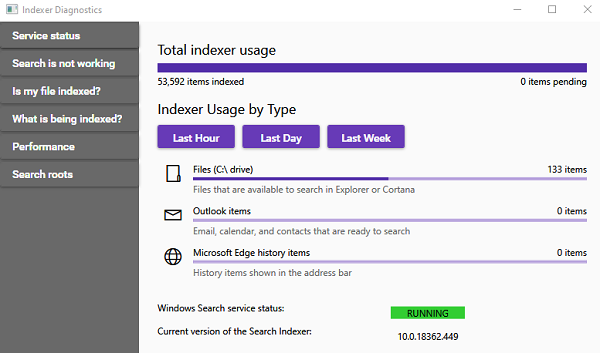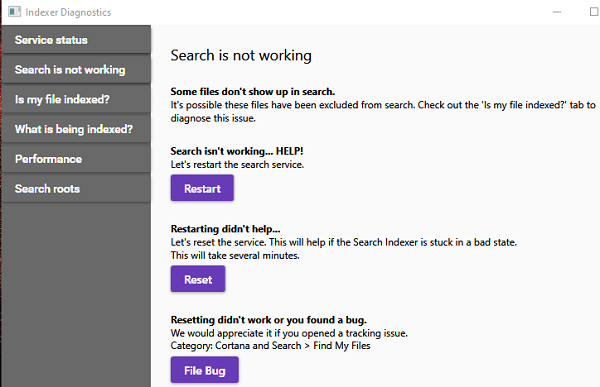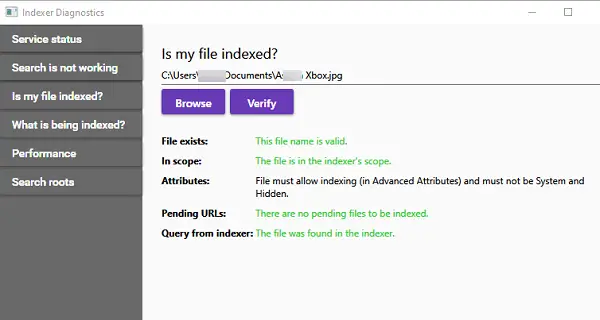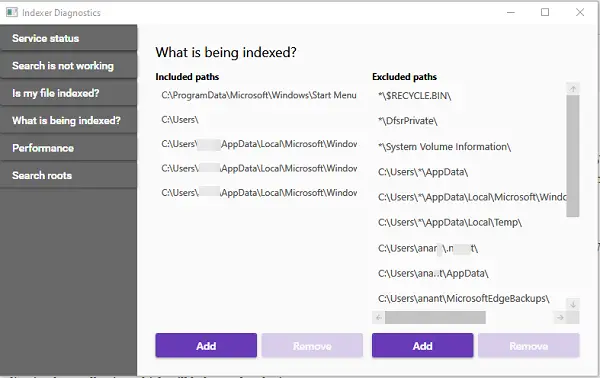Windows Search Indexer is a service in Windows 11/10 that ensures that a file or content is found inside it when you request it. But like any other service on Windows, it’s not without issues. Sometimes, it causes high CPU usage, and sometimes, it just doesn’t work. Microsoft has rolled out the Indexer Diagnostics Tool, which can identify problems with the Windows Search Indexer.

Indexer Diagnostics Tool from Microsoft
When you launch the diagnostic tool, be prepared to be impressed. It is not just another fix-it tool from Microsoft but a well-done app! On the left, you have the following menu:
- Service Status
- Search is not working
- Is my file indexed
- What is being indexed?
- Performance
- Search Tools
It offers many tools to check for problems that Windows Search often faces. When you are unable to find a file or the service is off, you can find a solution using this app.
Fix Windows Search Indexer problems
1] Service Status
It is the dashboard where you can see the number of indexed files, the list of drives indexed, Outlook items, and Microsoft Edge History items. You can filter the usage by the last hour, day, or week. You can also see the search service status and version.
2] Search is not working

If Windows Search is not working, this section will help you fix it. It includes problems such as Search ist not working, Restarting didn’t help, Restarting didn’t work because of bug.
3] Is my file indexed

If one of your files does not appear in the search results, you can check the status here. The diagnostic tool will help you identify the exact problem. For example, in the above image, the file’s advanced attributes have a problem. The rest of the checks were fine regarding the file’s existence, scope, pending URLs, a query from the indexer, and more.
4] What is being indexed?

It lists drives and folders that are included for indexing and paths that are excluded. You can manually add folder paths to both of them.
Read: How to prevent users from indexing Specific Paths in Search Index on Windows
5] Performance
Indexer Diagnostics tool displays the number of failed/successful queries in Windows. Along with it, you will see:
- Resource Tracing if the search indexer is using too many resources.
- Functional tracing and application log collection will help resolve the issue.
- The File Bug button enables you to submit input using the Feedback Hub.
6] Search Roots
This is only for information and shows where the indexer will begin its search.
Indexing issues are widespread, and this tool should make it easy for anyone to figure out and resolve problems. It is available for download in the Microsoft Store.
I hope the tool helps you resolve Windows Indexing issues.
How do I improve Windows indexing?
To ensure that the index reflects your changes, go to Settings > Search > Searching Windows > Advanced Search Indexer Settings > Advanced > Rebuild. Allow the Indexer to run for up to 24 hours to rebuild the index database.
Is it OK to disable Windows Search Indexer?
Please remember that disabling indexing can result in slower searches. If indexing is turned off, your computer must scan through the entire disk instead of using the index. This slowdown is particularly noticeable on mechanical drives, but even SSDs can be affected. Therefore, it’s essential to consider your usage patterns before deciding whether to disable indexing.
Leave a Reply